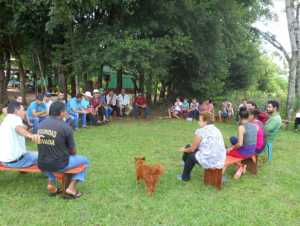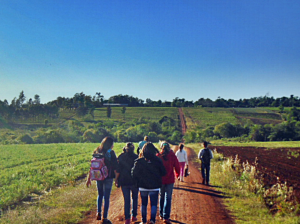This project is made possible through the partnership of WATER CHARITY and the NATIONAL PEACE CORPS ASSOCIATION. ![]()
This project has been completed. To read about the conclusion, scroll down below.
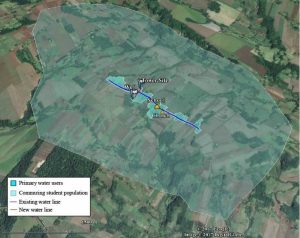 Location
Location
This project summary has been redacted for security reasons to omit the specific project location.
Barrio Xxx Xxxxx, Maria Auxiliadora, Arquitecto Tomás Romero Pereira District, Department of Itapúa, Paraguay
Community Description
Xxx Xxxxx is a small agricultural community in the southern department of Itapúa, nestled within what remains of the Paraguayan Atlantic Forest. 2017 unofficial census data reports that 36 families and over 200 people live in the community, with many more children than commute from surrounding communities to attend the school which offers primary and an accelerated high school programs.
Most families are subsistence farmers, with their primary source of income based around the production of soy, wheat, corn, beets and carrots cultivated for exportation. The community’s small producers and women’s committee also produce a variety of animal products and artisanal items that they sell locally and in the nearby pueblo of Maria Auxiliadora. Much of social life revolves around the church and school events, community organizational group meetings, and soccer games that are held most Sundays.
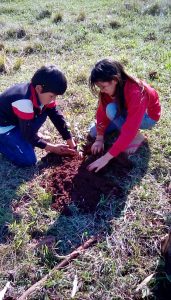 Problem Addressed
Problem Addressed
While most highly populated areas in Paraguay have access to running water, there are still many interior communities that lack access to potable water, resulting in higher rates of illness, inappropriate waste management, and poor sanitation practices.
Many families in Xxx Xxxxx have a shallow common well on their property or are within walking distance of one, but recurring dry summers have made it so that a reliable water source is not always available for drinking, animal care, or crop production. Intensively farmed soy and unsustainable farming practices have resulted in substantial water contamination. Disease from waterborne illness is a consistent issue for many families.
The community school has been without running water for much of its existence, affecting more than 200 children. While the students often bring their own water by bottle, they tend to commute to the school by foot and often exhaust their water rations before class starts, with no way to refill their bottles for the rest of the day. This is the main concern of the community, which affects families living inside and around the proposed water system.
For the past decade, the community had been working with the national organization SENASA to establish a well, tower, and water line system that would reach community houses, a church, and a school. Due to a series of unfortunate circumstances, the community had been left with an unfinished system attached to a dry well at the end of the government project in 2004. That project left more than 6 kilometers of connected and installed water lines off the main road in the community. The neighborhood has since completed another well with the help of the municipality, but funding has been stretched thin, considering the neighborhood is one of many that have the same problem in the district.
Project Description
This project is to complete the water system, including installing a pump on the well, building a water tower and tank, and installing water lines to the remaining houses in the community.
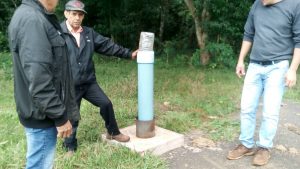 The well and tower site are on the properties of community members that have agreed to donate the use of their land to house the well-system, lines, and tower.
The well and tower site are on the properties of community members that have agreed to donate the use of their land to house the well-system, lines, and tower.
The well was excavated in 2016 at a depth of 120 meters with a water pressure of 12,000 liters/hour (as of testing date 07/05/2017).
The primary components of the project will be to:
(1) Coordinate with the water commission leaders, the local municipality, and the well company’s engineer to equip the well with a motor and transformer
(2) Erect and connect the 15,000-liter steel water tower to the well system
(3) Utilize a government-donated backhoe to excavate and install short distance water lines to the remaining 16 of 36 community properties that are not already connected to the system
(4) Work with community leaders to establish water system management techniques, and water hygiene and quality standards
Water Charity funding will be allocated to cost of the electric submersible 3 HP/220 Monofasico motor with a 1.25 inch, 10 kg pressure internal pipe, a 10 Kva transformer with concrete post and electric meter, 280 meters of 16 mm copper cable, 7 hardwood posts, and necessary electrical installation/ documentation with the national electric company
The construction of the 15,000-liter steel tank, tower, grounding rods, beacon, transportations fees, and subsequent polyvinyl chloride (PVC) water lines will be the responsibility of the community and municipality who have agreed to contribute this financial and labor-intensive support to the project.
A series of workshops on effective leadership and organization will be conducted, facilitated by Peace Corps Volunteers (PCVs), covering topics related to water system management, organizational transparency, and accountability standards. Through these workshops, the commission and community members have the opportunity to develop and implement a long-term management plan for the water system, resulting in a stronger relationship of respect and trust among the community members that will ensure the longevity of the water system.
Project Impact
400 people will benefit from the project.
Peace Corps Volunteers Directing Project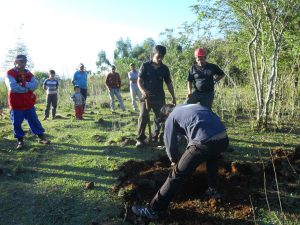
R. Rasmussen and R. Martinez
Monitoring and Maintenance
Currently serving PCVs will continue to monitor the project through the end of their services (December 2017), but the main focus is placed on the community’s water commission to conduct long-term management of the water system and its continued maintenance.
Long term sustainability will be achieved through the following steps:
(1) The establishment of a sustainable long-term water system maintenance plan and payment schedule agreed upon by community members
(2) Commission leadership participation in and co-facilitation of educational workshops with PCVs and community members on the workings of the water system and its long-term management
(3) Conducted workshops (facilitated through the current PCVs) with commission leaders on effective organizational leadership, focusing on the importance of accountability, communication, and transparency
(4) Collaborative teachings (facilitated by community leadership and current PCVs) at the school that focuses on water quality, hygiene, and the prevention of waterborne illness.
The water system will be installed by an engineer from a reputable company and will provide the community with a 1-year system guarantee and continuous on-call maintenance support.
This project has been funded through the generosity of the Paul Bechtner Foundation.
Conclusion of Maria Auxiliadora Water Project – Paraguay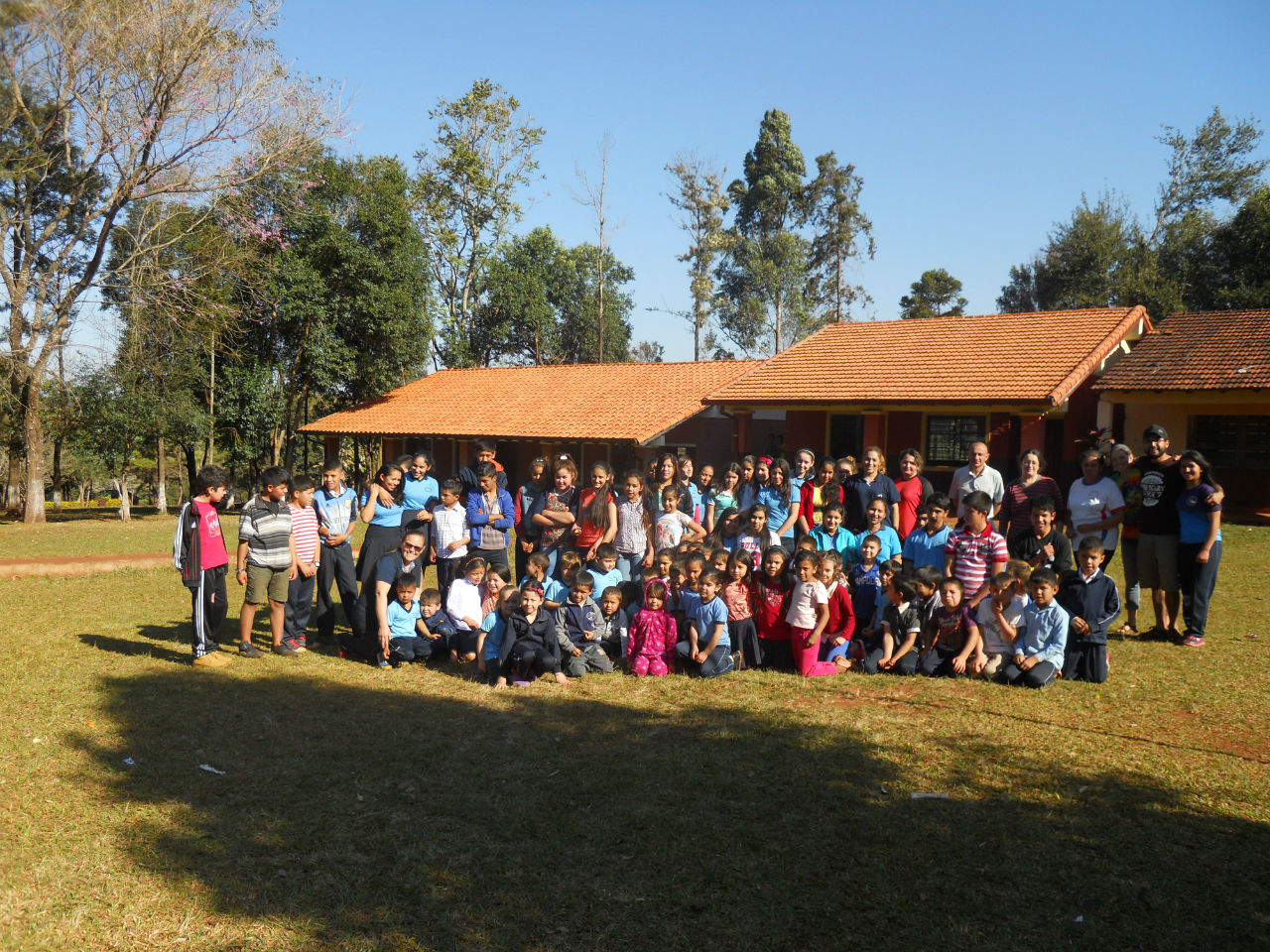
This project has been completed under the direction of Peace Corps Volunteer Rachel Rasmussen. To read about the start of the project, CLICK HERE.
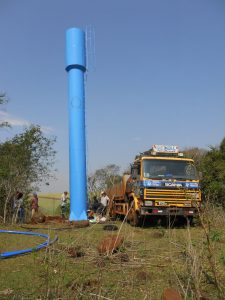 The project was designed to complete the water system, including installing a pump on the well, building a water tower and tank, and installing water lines to the remaining houses in the community.
The project was designed to complete the water system, including installing a pump on the well, building a water tower and tank, and installing water lines to the remaining houses in the community.
Rachel reports:
This project retrofitted a 120-meter well with the necessary equipment that will supply over 40 families, a church, and a school with potable water.
Project Scope and Completed Activities
The serving PCVs in collaboration with community leadership aimed to outfit a 120-meter well dug by the municipality with the equipment needed to establish a water system for community households, a school, and a church with potable water.
This system was designed and implemented with long-term sustainability in mind, in-part to combat reducing waterborne illness in the community. The project included a capacitation component that trained the community water commission on successful community organization tactics to insure the project’s proper administration and maintenance.
The project was conducted over an 11-month period, with community meetings and workshops held bi-monthly and the construction of the water system reached completion in August 2017.
The activities set up to meet the project goals and additional personal comments by the lead Peace Corps volunteers are as follows:
(1) PCVs and Water Commission conducted and facilitated educational workshops with community members and future water system users to discuss effective organizational leadership, focusing on the importance of accountability, communication, and transparency (December 2016 through November 2017).
We saw a lot of development over the course of these meetings. There was a clear progression of the community members’ understanding of the project and the importance of participation. The meetings served as an opportunity for community members to voice their doubts and hopes for the system. It also gave the commission leaders the opportunity to converse with the users of the water system and better establish a relationship of respect and authority.
We were amazed to see the growth in participation from the first meeting to the last. It was really something to witness more women and young people contributing and exercising their voice in this atmosphere. With more community sharing in these meetings, the more traction we could see in project advancement. Families felt involved in the project and took ownership of their responsibility to the system they were trying to construct.
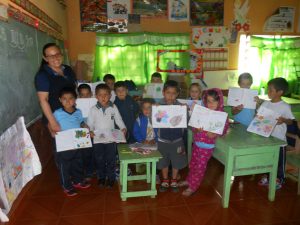 (2) PCVs and Community leadership attended productive meetings with local municipality leadership to secure funding for the project water tower and use of municipality backhoe to dig water lines (February 2017 through June 2017).
(2) PCVs and Community leadership attended productive meetings with local municipality leadership to secure funding for the project water tower and use of municipality backhoe to dig water lines (February 2017 through June 2017).
Over the course of these meetings, we worked to establish a working relationship between the leadership of our commission and the local government leadership. We tried our best to make our project not about politics, but rather about the service that was to be done for the people. We cultivated a positive connection with the mayor and an empowered voice for our commission leaders, who now better understand their own agency and ability to work within their own system for continued development.
(3) PCVs coordinated with the water commission leaders, the local municipality, and the well company’s engineer to establish a plan to equip the well with a motor and transformer (June 2017).
The majority of our interactions with the Well Company were positive ones. We are grateful that the committee leadership has established a positive working relationship with the engineer of this company, which has provided consistent support to the commission leadership in all phases of this system. The one-year guarantee included in the work of the project helps to ensure long-term sustainability, and we are confident that the engineer is invested in the future of this project.
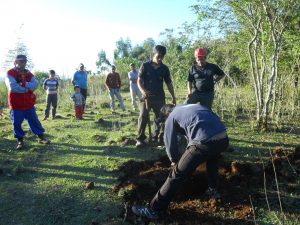 (4) PCVs and Water Commission Leadership conducted workshops to draft and establish a sustainable long-term water system maintenance plan and payment schedule, as agreed upon by community members (June 2017 through November 2017).
(4) PCVs and Water Commission Leadership conducted workshops to draft and establish a sustainable long-term water system maintenance plan and payment schedule, as agreed upon by community members (June 2017 through November 2017).
These community-wide meetings have been an easy transition for community members, who already feel confident in expressing their opinions in regard to the system. Participation in these discussions has been excellent and we are confident in the ability of the commission and community members to maintain the water system.
Once the system was turned on the community felt that much more confidence in the program and enthusiasm is high. After all, by this point, we all have been involved in this project together, and are invested in its continued success.
(5) Well company arrived at the project site to install the motor and transformer to the existing well system, as well as to erect and connect the 15,000-liter steel water tower to the well system (August 2017).
The entirety of the system construction occurred over a three-week period, as concrete was poured and dried, community members and future users of the system volunteered their time to dig water lines and secure the well’s perimeter with community-donated fencing and posts. The construction site became a popular place to hang out during this time, and many people simply showed up to watch the construction.
(6) The local government donated the use of a backhoe to excavate and install short-distance water lines to the remaining 16 of 36 community properties not already connected to the system (August 2017).
Major lines were done by the municipality (lines that crossed the main road) and others were completed by community members by hand. Some were nervous about the resolve of government participation, but we were all pleasantly relieved to see the fruits of our cultivated relationship with the municipality.
Now there seems to be a more present relationship with the community’s organizational leadership, and have continued presence at many commissions meetings as of late. There was a great feeling of togetherness during this period, as the prospect of running water was all community members talked about.
(7) PCVs Worked with community leaders to establish more detailed water system management techniques, and water hygiene and quality standards (September 2017).
This, we believe, will be an on-going process. As the system settles into itself and commission leaders gain hands-on experience, the community will develop a trust-based understanding of the quotidian necessities of the system. We are very optimistic about long-term sustainability and believe that the commission and community members are more than ready for the task of maintaining this system.
Project Sustainability
From the capacity-building component of our grant to consultations with the well company, the sustainability and longevity of the project have always been the priority. By working with community leaders to best establish trustful relationships and a working user contract with community members, we feel they are better prepared for the responsible and consistent management of the water system.
As a part of the contract, the one-year guarantee will allow for temporary professional maintenance and integrity of the well system, and community members feel comfortable and empowered to exercise this resource. The commission leadership is aware of the ephemeral nature of that agreement, which is why the commission leadership designated a community member with a plumbing experience as a local technician.
Most importantly, by securing the full funding of this potable water system, the community can have a fresh start in fundraising for future maintenance costs and do not have to fear a large debt that may have taken decades to pay off.
Goals Achieved and Community Feeling
In alignment with our three goals, a water system has been established and lines connected for 36 community families, as well as the church and school. With an on-going series of workshops that will continue until the close of volunteers’ service, the water commission has worked to formulate a system framework and user contract that best serves the community.
Throughout the entirety of the project, community members and leadership have worked to strengthen community organization by conducting open-forum type meetings that have allowed for free expression of opinion and a generation of solutions for project roadblocks.
During the project site preparation and general construction, there has been an abundance of community volunteers to help with the digging of water lines, cooking food for the workers and establishment of security measures for the water tower.
Community meetings have had increasingly better attendance, especially from women and younger men. There is a general feeling of positivity now that potable water is available, for the security and well-being of each household. Each family has its own reason that drives them, but everyone is thrilled about what the future holds.
Again, we would like to extend our thanks to Water Charity and all those individuals and organizations that pulled together and supported us through this project. We and all the people impacted by this project will forever be grateful for this precious gift.
We extend our thanks to Rachel for completing this important project and again express our gratitude to the Paul Bechtner Foundation for providing the funding.
